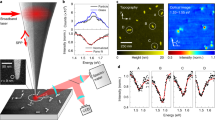Abstract
The well-known spatially distributed form of the near field, associated with a dipolar source, is usually unsuitable for effecting the excitation of a location-specific detector in the vicinity. It is of interest, therefore, to identify a means of producing a much more greatly directed character to such a near field, imposing features that are more commonly associated with longer-range, wave-zone electromagnetic propagation. In this paper, it is shown that nonlinear optical coupling with off-resonant, throughput laser light can achieve this effect. Based on a quantum electrodynamical analysis it is shown that two mechanisms contribute; one requires both the source and detector to be irradiated by the throughput radiation, the other can operate with the source alone irradiated. The analysis leads to results identifying the dependence of each mechanism on the relative directions of the laser beam and the source–detector displacement. Contour maps of the ensuing near field, at the source emission frequency, exhibit a directionality that grows with the off-resonant beam intensity. The phenomenon affords a means of achieving optical control over the near-field distribution.
Similar content being viewed by others
References
Y. Shen, P.N. Prasad, Appl. Phys. B 74, 641 (2002)
L. Novotny, B. Hecht, Principles of Nano-Optics (Cambridge University Press, New York, 2006)
D.W. Pohl, Philos. Trans. R. Soc. Lond. A 362, 701 (2004)
J.-H. Kim, K.-B. Song, Micron 38, 409 (2007)
W.L. Barnes, A. Dereux, T.W. Ebbesen, Nature 424, 824 (2003)
A.V. Zayats, I.I. Smolyaninov, A.A. Maradudin, Phys. Rep. 408, 131 (2005)
S.A. Maier, H.A. Atwater, J. Appl. Phys. 98, 011101 (2005)
G. Juzeliūnas, D.L. Andrews, in Resonance Energy Transfer, ed. by D.L. Andrews, A.A. Demidov (Wiley, Chichester, 1999), Chap. 2
L. Mandel, E. Wolf, Optical Coherence and Quantum Optics (University Press, Cambridge, 1995), p. 871
D.L. Andrews, Can. J. Chem. 86, 855 (2008)
P. Allcock, R.D. Jenkins, D.L. Andrews, Chem. Phys. Lett. 301, 228 (1999)
P. Allcock, R.D. Jenkins, D.L. Andrews, Phys. Rev. A 61, 023812 (2000)
D.S. Bradshaw, D.L. Andrews, J. Chem. Phys. 128, 144506 (2008)
D.S. Bradshaw, D.L. Andrews, Eur. J. Phys. 25, 845 (2004)
Author information
Authors and Affiliations
Corresponding author
Rights and permissions
About this article
Cite this article
Bradshaw, D.S., Andrews, D.L. The control of near-field optics: imposing direction through coupling with off-resonant laser light. Appl. Phys. B 93, 13–20 (2008). https://doi.org/10.1007/s00340-008-3144-x
Received:
Published:
Issue Date:
DOI: https://doi.org/10.1007/s00340-008-3144-x




